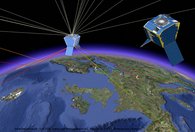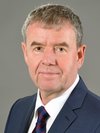A major motivation for the small satellite activities at GFZ was the extremely successful GPS radio occultation experiment aboard the CHAMP satellite [1]. Later, the application of GNSS-R within future generation Tsunami Early warning systems was investigate in more details as part of the GITEWS project [2]. Based on these investigations in total three feasibility studies for the definition of small satellite projects with scientific GNSS payload were performed: MicroGEM [3], NanoGEM [4], and NanoX [5]. Additional objective of these missions is geodetic co-location using three different space geodetic techniques (GNSS. VLBI and SLR).
GFZ is recently involved in small satellite project for GNSS-Reflectometry of the RUAG company in cooperation with the European Space Agency ESA (PRETTY, [6]).
[1] Wickert, J.; Reigber, C.; Beyerle, G.; König, R.; Schmidt, T.; Grunwaldt, L.; Galas, R.; Meehan, T.; Melbourne, W. G.; Hocke, K.: Atmosphere sounding by GPS radio occultation: First Results from CHAMP. Geophysical Research Letters, 28, 17, 3263-3266, 2001.
[2] Stosius, R.; Beyerle, G.; Hoechner, A.; Wickert, J.; Lauterjung, J.: The impact on tsunami detection from space using GNSS-reflectometry when combining GPS with GLONASS and Galileo on GNSS-Reflectometry tsunami detection from space. Advances in Space Research, 47, 5, 843-853, 2011.
[3] Briess, K., Kornemann, G., Wickert, J., MicroGEM: Microsatellites for GNSS Earth Monitoring, Abschlussbericht Phase 0/A, pp. 244, 2009.
[4] Wickert, J., Rothacher, M., Brieß, K., Wahnschaffe, G., Pilz, N., NanoGEM: Phase A, Schlußbericht, pp 144, 2011.
[5] Buhl, M., Segert, T., Wickert, J., Rothacher, M., Machbarkeitsuntersuchung Nano-X, Abschlussbericht Phase 0, pp. 121, GFZ-TN03, 2012.
[6] Fragner, H., Dielacher, A., Zangerl, F., Koudelka, P., Høeg, P., Beck, P., Wickert, J., PRETTY: Grazing altimetry measurements based on the interferometric method, Proc. ARSI-KEO workshop, ESA, September 2017.



